Universal Rating Converter for 2024
NoseKnowsAll • September 24, 2024
Have you ever wondered what your different OTB ratings would be?
This month, I was tasked by ChessDojo to improve their rating converter that maps the vast majority of classical chess ratings to each other. Most of us have heard about the FIDE rating boost that was applied in March 2024 to all players under 2000 FIDE. Because of the seismic shift this rating compression created in FIDE ratings, I decided to start from scratch and generate new ways to map all the ratings to each other. A key challenge in creating this universal rating converter was determining which ratings were stable and reliable, and which ratings should be largely ignored.
The Universal Rating Converter
Without further ado, here is the universal rating converter, updated in September 2024. If you have a classical chess rating either online or OTB, you should be able to look up your cohort and approximate what rating you would have in any other rating system*** by simply reading across the row!
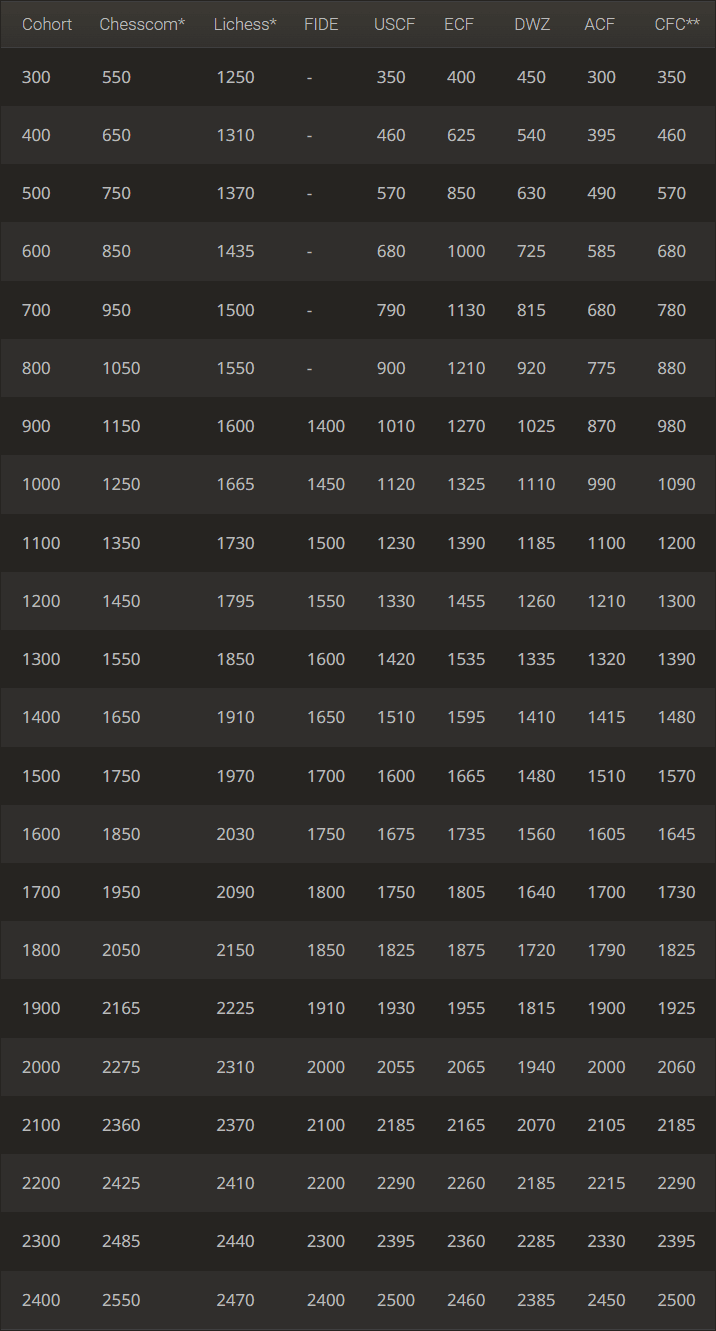
* The above ratings refer to your classical Lichess rating or rapid Chess.com rating. Blitz ratings do not apply.
** My CFC data sources are a bit lacking, so please take those numbers with a grain of salt.
*** I cannot include every single classical rating system in this converter, but hopefully I have covered the majority of them.
Determining The Converted Ratings
The ultimate goal of this converter is to be able to accurately compare a player's strength across all the rating systems even if they only have played classical games in one or two of these rating systems.
In determining these numbers, I compared OTB ratings to other OTB ratings when available. I also compared OTB ratings to online ratings (with low rating deviation) when available.
I took data from many sources: thousands of ChessDojo training program members who had low rating deviations in their classical Lichess ratings and/or rapid Chess.com ratings but also had an OTB rating, the FIDE player list, the ACF player list, the DWZ player list, and the ECF player list, all from September 1st 2024. I tried to only consider data that was reliable by basing the ratings mostly on online:OTB ratings for the lower rated cohorts and OTB:OTB ratings for the higher rated cohorts. Since the pool of online players thins out dramatically near the very top, I can only truly compare their OTB ratings to each other.
As an example, consider someone who has a 1550 Lichess classical rating, 1050 Chess.com rapid rating, and 1430 FIDE rating. They are much more likely to have accurate online ratings rather than OTB. In contrast, someone who has a 2300 Lichess classical rating and 1850 Chess.com rapid rating, but is 2100 FIDE and 2300 USCF is much more likely to have accurate OTB ratings. There are a variety of reasons why someone of that strength has a low Chess.com rating (they prefer Lichess, they use Chess.com just to try random openings, they don't care about that rating and so are happy to abort the occasional game, they don't like running into cheaters and so don't play often). Therefore, my model won't weigh them heavily when determining the FIDE:Lichess mapping, for instance.
Now let's play with the underlying data and create some interesting plots!
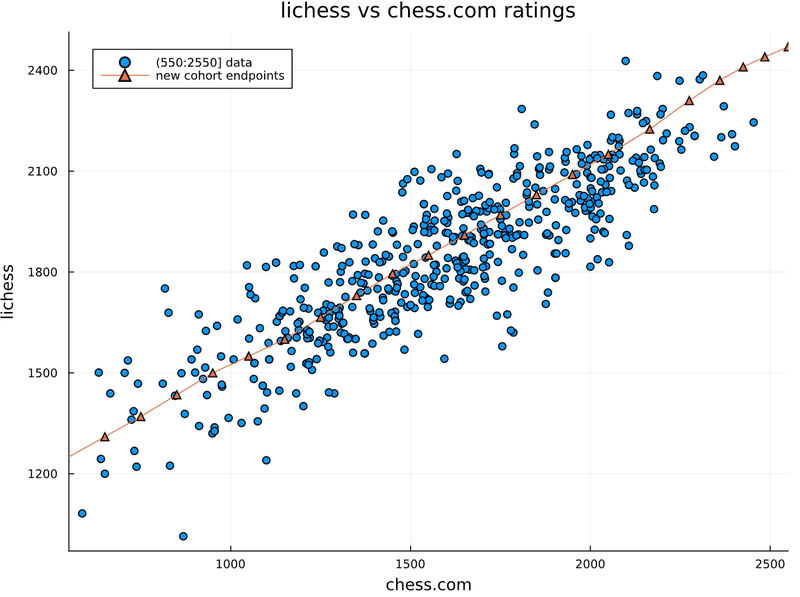
The above plot only includes accurate Lichess classical and accurate Chess.com rapid ratings of ChessDojo training program members.
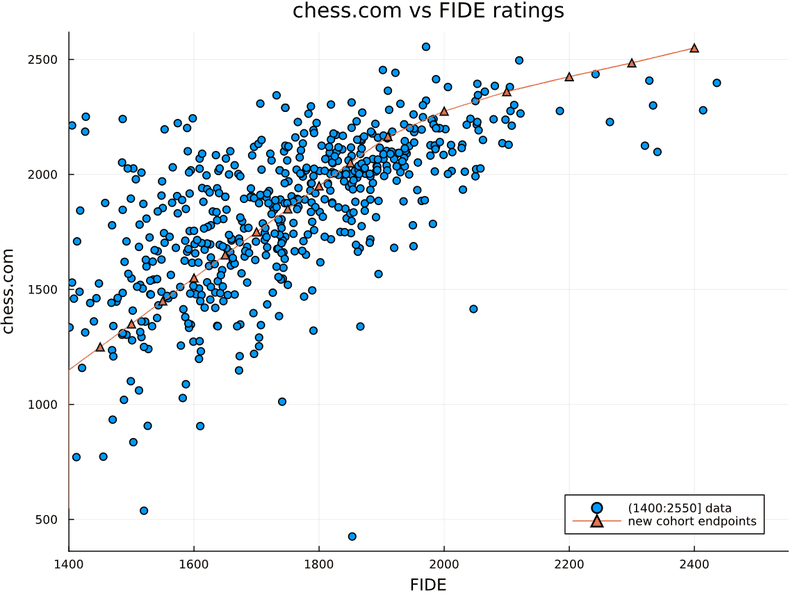
The above plot only includes accurate Chess.com rapid ratings and FIDE standard ratings of ChessDojo training program members.

The above plot only includes accurate Lichess classical and accurate USCF regular ratings of ChessDojo training program members.

The above plot only includes accurate USCF regular ratings and FIDE standard ratings of ChessDojo training program members.
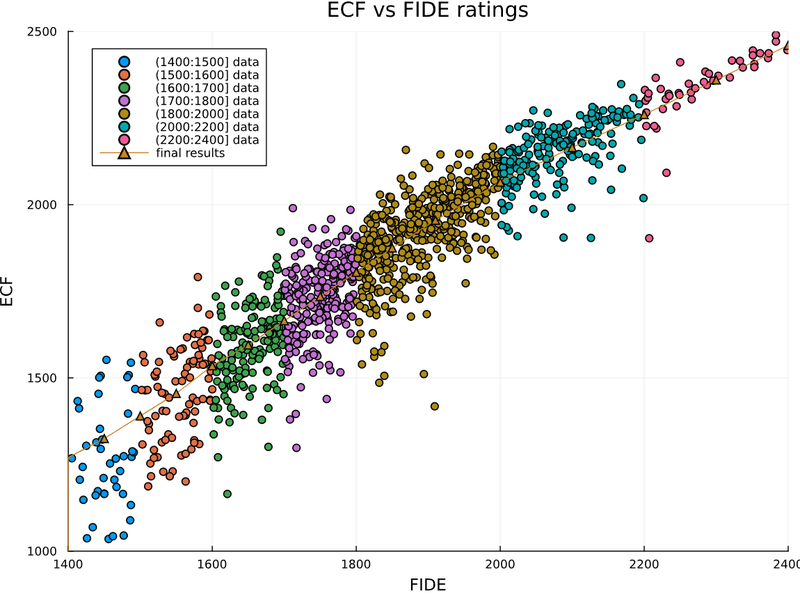
The above plot includes all active ECF members with a FIDE rating as of September 1st, 2024.
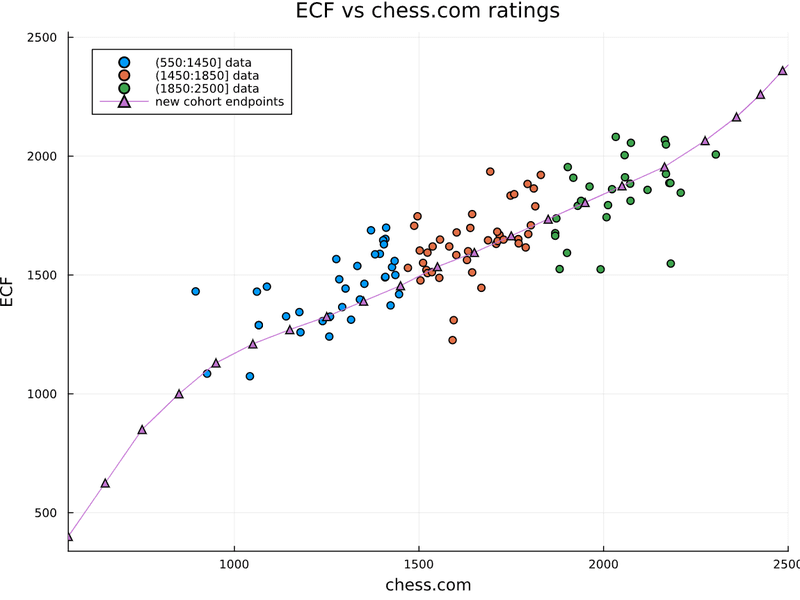
The above plot only includes ECF ratings and accurate Chess.com rapid ratings of ChessDojo training program members.

The above plot includes all active DWZ members with a FIDE standard rating as of September 1st, 2024.
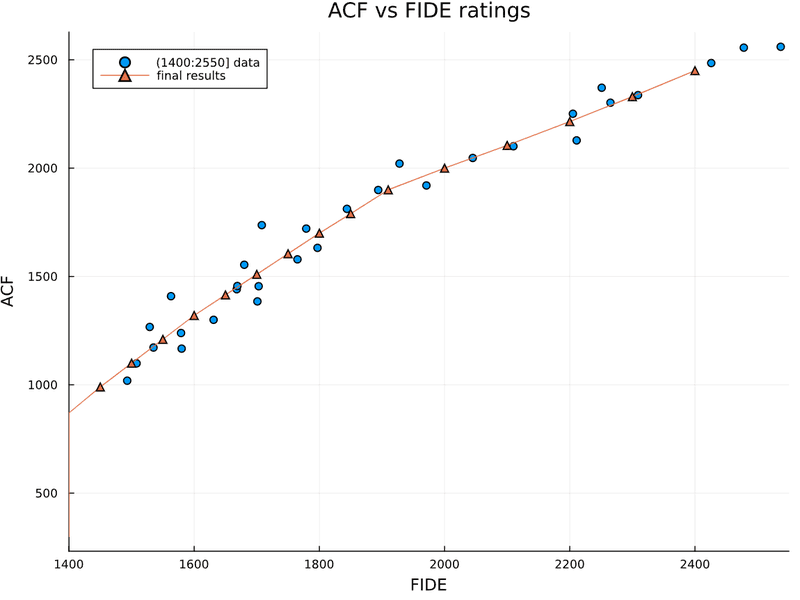
The above plot only includes representative ACF members, who were hand-picked by ACF for their accurate ratings, with a FIDE standard rating as of September 1st, 2024.
Interesting Conclusions
Based on my input data and the above plots (among others I generated - I did not want to burden readers with infinite plots!), we are able to draw some interesting conclusions.
- Even the absolute lowest OTB ratings don't correspond well to online ratings. Anyone rated under 1250 Lichess classical or 550 Chess.com rapid is characterized as a complete beginner according to most OTB ratings shown above. That's practically 20% of all Lichess classical players and 42% of all Chess.com rapid players. That gives you an idea of how much tougher OTB is compared to online. You should be stronger than a decent amount of online players before it makes any sense to even try for an OTB rating.
- The absolute top of the online rating pools do not provide reasonable estimates for OTB ratings. I would personally draw the line at 2275 Chess.com rapid and 2310 Lichess classical ratings --- those are probably the highest online ratings to provide an accurate estimate for OTB strength. Above that, you simply don't have a player base on either website. These ratings corresponds to the 99.5 percentile on Lichess and the 99.9 percentile on Chess.com. According to my estimator, gaining a measly 160 Lichess classical rating points takes you from a good club player at 2000 FIDE to GM strength. That shouldn't make sense to you because it doesn't make sense! There just aren't many titled players playing classical time controls online for that rating to be meaningful.
- USCF players indeed do not have accurate FIDE ratings until roughly the 2000 FIDE mark. This is shown by the fact that the model comparing the ratings underestimates the actual FIDE ratings of the players until near the top. This effect has been noted by many people in the past - there simply are not enough FIDE tournaments in the USA for players to get an accurate FIDE rating. To a lesser extent, this is true when comparing the ECF to FIDE ratings as well.
- ECF has reported an easy way to compare ECF and FIDE ratings. Based on my results, I believe their measurement underestimates a player's FIDE rating for the low end and overestimates a player's FIDE rating for the high end. If you want an extremely simple estimator, I think a more accurate estimate is ECF = 1.4 * FIDE - 715 under 1940 FIDE, and ECF = FIDE + 60 for players over 1940 FIDE. If you want to flip the mapping around: FIDE = 1/(1.4) * ECF + 510 for players under 2000 ECF, and FIDE = ECF - 60 for players over 2000 FIDE. Hopefully, this more accurate mapping is clean enough for ECF members to prefer instead.
- The sad necessity to use Chess.com rapid ratings rather than a classical rating is annoying. If Chess.com had a classical time control, then we would truly be able to compare apples to apples. Unfortunately, they do not have a classical time control. Therefore, this converter unfortunately is unevenly influenced by comparing 10+0 games on Chess.com to 90+30 games OTB and on Lichess. There's no way around that, and it makes for a less satisfying comparison with what is the biggest player base: Chess.com users.
- I didn't have more than a few hundred (some of which were not accurate) data points to work with when deriving the CFC rating comparisons. Please take those numbers as broad approximations with a grain of salt.
Final Thoughts
I hope you have gotten something useful out of this universal rating converter! Let me know in the comments if you see something else surprising that you think I should address.
If you are looking for a structured training program for all levels from 0-2500 along with an active and supportive community, please check out the ChessDojo training program, for whom I was originally tasked with creating this converter. There is a free version if you're just looking for what training plan they suggest for each of the cohorts. Personally, I've been a paying member for more than 2 years now and couldn't be happier with the community and material they recommend.
